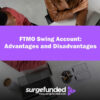How HFT traders manage risk in prop firms is a difficult undertaking that calls for a diversified strategy. HFT has dramatically changed the financial markets as it allows traders to perform several thousand orders in less than a second. While high-speed and low-margin HFT generates substantial revenues, it also brings special risks. Prop firms that operate HFT will have to establish appropriate risk management practices in an attempt to know how HFT traders manage risk in prop firms and make them viable in the long term. This article talks about how HFT traders manage risk in prop firms; the focus would be mainly on risk management frameworks, trading strategies, and psychological factors.
What Is HFT
HFT is a sophisticated algorithmic and high-speed data networking platform to exploit small price discrepancies across markets. Traders depend on technology to analyze market conditions and execute trades at lightning speed. However, this method is not without its risks, including liquidity risk, market impact risk, and operational risks related to technology failures.
Risk Management Frameworks in Prop Firms
Considering How HFT traders manage risk in prop firms, Prop firms work under strict conditions of risk management, which do not jeopardize their capital but at the same time allow traders to follow strategies which will work in their interest. A typical framework in this regard should include:
- Pre-Trade Risk Controls: Firms evaluate the possible risks connected to each order prior to placing trades. Limiting the maximum amount a trader can lose in a single deal or in a single day may be one way to achieve this. Strict position sizing guidelines that specify the maximum amount of capital that can be invested in each trade are frequently imposed on traders.
- Real-Time Monitoring: Prop firms use sophisticated monitoring systems to get data on trading activity in real time. If a trader gets too close to their risk tolerance or if odd trading patterns are noticed, these systems may sound an alarm. This makes it possible to take quick action, such as stopping deals or changing positions.
- Post-transaction Analysis: Following transaction execution, businesses carry out in-depth assessments to compare performance to anticipated results. This research aids in locating any disparities that might point to deeper problems with a trader’s execution or plan.
Key Risk Management Strategies
There are a few specific strategies on How HFT traders manage risk in prop firms effectively:
- Position Sizing: Position sizing means a trader decides on his size or the quantum of position taken up relative to capital, using pre-defined amounts of risk. This can temper the effects of losses on one’s portfolio by minimizing the size of any one trade.
- Stop-Loss Orders: Those orders which are given for the automatic closure of an open position when the latter reaches a certain threshold of loss. The stop loss order helps in limiting the loss and will avoid impulsive decisions in the case of high volatility of markets.
- Diversification: To spread risk across different asset classes or markets, traders often diversify their portfolios. This is designed to cushion one against adverse movements in any single security or market segment.
- Algorithmic Risk Management: Most prop firms possess and operate specially tailored algorithms for risk management. This adjusts the trading parameters in response to real-time market conditions and historical performance data.
Psychological Factors that Contribute to Risk Management
In the framework of risk management, it is impossible to ignore the psychological component of trading. HFT traders often face immense pressure to perform consistently due to the fast-paced nature of their work. Emotional decision-making brought on by this pressure could jeopardize risk management initiatives. In order to overcome these pressure or mental obstacles, prop firms promote:
- Maintaining Order and Following Trading Plans: In knowing How HFT traders manage risk in prop firms, proficient traders create thorough trading plans that specify their objectives, tactics, and risk control procedures. Following these plans reduces the likelihood of making snap decisions motivated by greed or fear.
- Training for Mental Fortitude: To improve traders’ emotional resilience, some prop firms include mental training approaches in their programs. Traders can practice making decisions under pressure without risking real money by using strategies like mindfulness exercises or simulated trading environments.
Risk management and regulatory compliance
Regulations that control trading activities must also be negotiated by prop firms. Respecting these rules is crucial for legal reasons as well as for preserving stakeholder and investor confidence. Among the successful compliance measures are:
- Frequent Audits: To guarantee adherence to regulatory requirements, firms regularly audit their trading operations and risk management procedures. These audits assist in locating possible trouble spots before they become serious problems.
- Open and Honest Reporting: For regulatory compliance, documenting trading actions and risk exposures in a transparent manner is essential. Regulators frequently receive comprehensive reports from prop firms detailing their trading tactics, risk management procedures, and overall performance indicators.
In conclusion
How HFT traders manage risk in prop firms is a challenging task that calls for a diversified strategy. Comprehensive risk management systems, including pre-trade restrictions, real-time monitoring, post-trade analysis, and trader psychology training, are implemented by proprietary trading organizations. HFT traders can handle the dangers of this fast-paced environment while aiming for profitability by utilizing efficient tactics such as position sizing, diversification, stop-loss orders, and algorithmic risk management.
How HFT traders manage risk in prop firms will become even more crucial as the financial markets’ environment changes in tandem with technology. Understanding these strategies is crucial for HFT traders working for prop firms to maintain long-term success in a field that is becoming more and more competitive, not simply for capital protection.
Frequently Asked Questions
1. What Is HFT
- HFT is a sophisticated algorithmic and high-speed data networking platform to exploit small price discrepancies across markets. Traders depend on technology to analyze market conditions and execute trades at lightning speed.
2. Risk Management Frameworks
- Pre-Trade Risk Controls
- Real-Time Monitoring
- Post-transaction Analysis
3. Key Risk Management Strategies
- Position Sizing
- Stop Loss Orders
- Algorithmic Risk Management
- Diversification
4. Psychological Factors that Contribute to Risk Management
- Maintaining Order and Following Trading Plans: In knowing How HFT traders manage risk in prop firms, proficient traders create thorough trading plans that specify their objectives, tactics, and risk control procedures. Following these plans reduces the likelihood of making snap decisions motivated by greed or fear.
- Training for Mental Fortitude: To improve traders’ emotional resilience, some prop firms include mental training approaches in their programs. Traders can practice making decisions under pressure without risking real money by using strategies like mindfulness exercises or simulated trading environments.


















